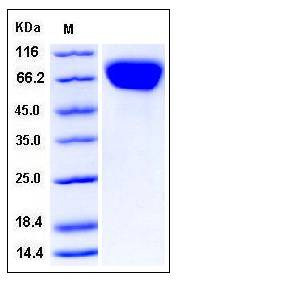Human FLRT3 Protein (His Tag)
HH21
- 100ug (NPP3870) Please inquiry
| Catalog Number | P11166-H08H |
|---|---|
| Organism Species | Human |
| Host | Human Cells |
| Synonyms | HH21 |
| Molecular Weight | The recombinant human FLRT3 consists of 511 amino acids and has a predicted molecular mass of 58 kDa. The apparent molecular mass of rh FLRT3 is approximately 60-70 kDa in SDS-PAGE under reducing conditions due to glycosylation. |
| predicted N | Lys 28 |
| SDS-PAGE |  |
| Purity | > 98 % as determined by SDS-PAGE |
| Protein Construction | A DNA sequence encoding the human FLRT3 (NP_938205.1) extracellular domain (Met 1-Pro 528) was expressed, fused with a polyhistidine tag at the C-terminus. |
| Bio-activity | Measured by the ability of the immobilized protein to support the adhesion of Neuro‑2A mouse neuroblastoma cells. When cells are added to coated plates(5μg/mL, 100μL/well), approximately 50%-70% will adhere after 1 hour at 37℃. |
| Research Area | Immunology |Signal Transduction |G protein signaling |G Protein-Coupled Receptors (GPCRs) |Chemokine Receptors |
| Formulation | Lyophilized from sterile PBS, pH 7.4 1. Normally 5 % - 8 % trehalose, mannitol and 0.01% Tween80 are added as protectants before lyophilization. Specific concentrations are included in the hardcopy of COA. |
| Background | Leucine-rich repeat transmembrane protein FLRT3, also known as Fibronectin-like domain-containing leucine-rich transmembrane protein 3, and FLRT3, is a single-pass type I membrane protein which belongs to the fibronectin leucine rich transmembrane protein (FLRT) family. FLRT3 contains one fibronectin type-III domain and ten LRR (leucine-rich) repeats and is expressed in kidney, brain, pancreas, skeletal muscle, lung, liver, placenta, and heart. It has a provocative expression pattern during somite development being expressed in regions of the somite where muscle precursor cells migrate from the dermomyotome and move into the myotome, and later in myotomal precursors destined to migrate towards their final destination. FLRT1, FLRT2 and FLRT3 are members of the FLRT family. The FLRT family of leucine-rich repeat (LRR) proteins is implicated in fibroblast growth factor (FGF) signalling, early embryonic development and neurite outgrowth. FLRT3 shares 55% amino acid sequence identity with FLRT1 and 44% identity with FLRT2. Two alternatively spliced transcript variants encoding the same protein have been described. The expression of FLRT3 is controlled by fibroblast growth factors (FGFs). FLRT3 has been implicated in neurite outgrowth after nerve damage, as a positive regulator of FGF signalling and in homotypic cell adhesion. FLRT3 may have a crucial role in regulating cellular adhesion between the epithelial apical ridge and the underlying mesenchyme and in establishing the dorso-ventral position of the ridge. |
| Reference |
